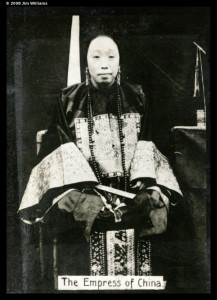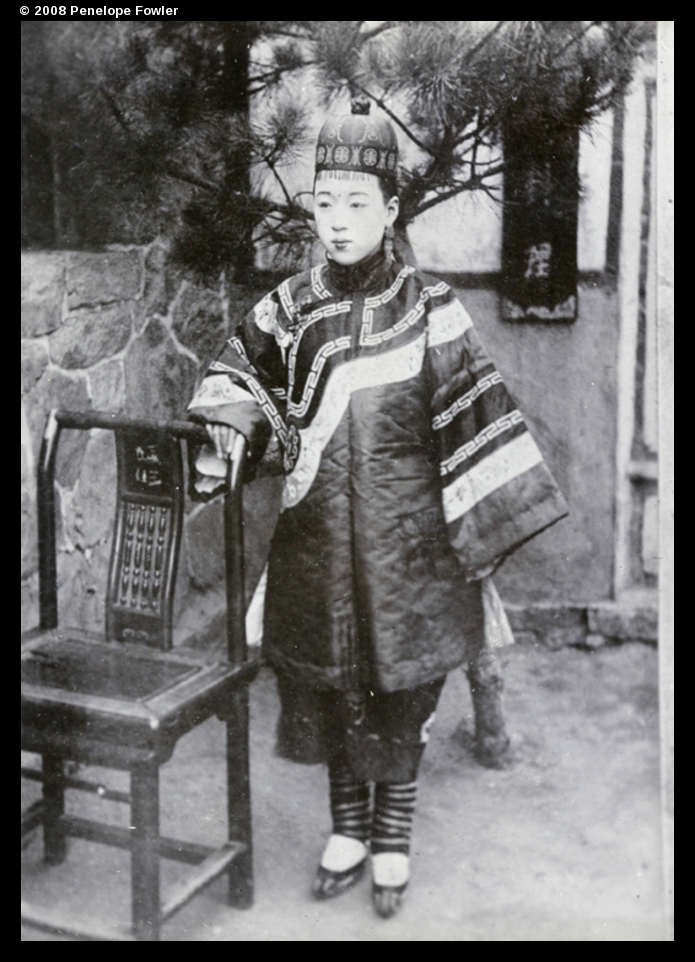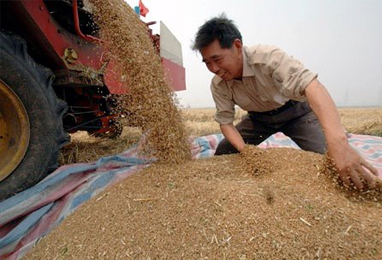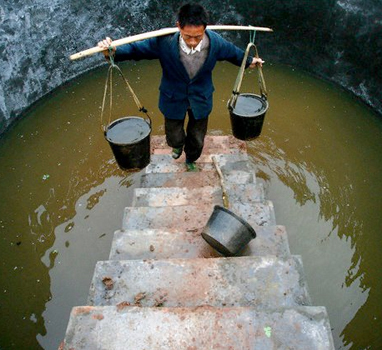Women in China
- Introduction
- Women Under China’s Dynasties – Confucianism and Women
- Marriage in Dynastic Times
- A Woman’s Life in Imperial China
- Foot Binding
- Encounters with the West Expose 19th Century China to New Ideas on Women
- May 4th Feminist Thinkers
- The 1949 Communist Revolution and Marxist Theory on Women
- The 1950 Marriage Law
- Women and Market Opening
- Trends
Introduction
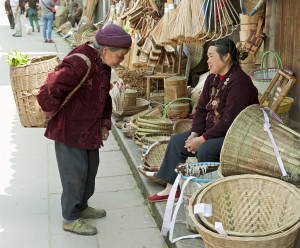
Since the founding of the People’s Republic of China in 1949, promoting greater equality between men and women has been a stated goal of the Chinese Communist Party (CCP). Mao Zedong famously proclaimed “In China, women hold up half the sky.” By this Mao appears to have meant that, if women were treated equally to men, China could better achieve its potential by taking advantage of the full complement of its population and workforce. The CCP thus supported the promotion of equal rights in all aspects of a woman’s life, at least at a rhetorical level.
Yet, even from its earliest days pre-dating the founding of the PRC, the support of Chinese women’s rights has been less about a woman’s potential to realize herself as an individual, and more about ways to use women’s emancipation as a tool to achieve national objectives. Before the revolution, the mainly male voices which advocated changing the traditionally subservient role of Chinese women did so in the belief that educated, more capable Chinese women would better be able to raise intelligent, morally sound sons. These sons could then build a strong China that could defend itself from foreign imperialism.
Despite CCP proclamations, a long historical tradition of male dominance and patriarchal authority has been deeply embedded in China’s culture since dynastic times. The CCP’s rise to power brought radical changes to Chinese society; but this traditional male dominance in both the work and social spheres has proven difficult to overturn, despite the real progress that Chinese women have made in obtaining the right to be educated, to work, to choose whom they marry, to divorce, to own and inherit property and to participate in political affairs. On the one hand, the profound changes that economic reform has brought to China have brought unprecedented opportunities to Chinese women; for instance, China has more self-made female billionaires than any other country. On the other hand, the government’s commitment to fight women’s inequality has taken a backseat to its desire to promote economic growth. As a result, in many ways, there has been a return to traditional gender expectations which have hampered the progress of Chinese women’s emancipation.
Women Under China’s Dynasties – Confucianism and Women
China’s deep roots of discrimination against women lie within its ancient Confucian traditions. The Confucian system, whose origins lie in the 551-479 BC period, encompassed the notion of “filial piety” – that women should obey men, citizens should obey their ruler, and the young should obey the elderly. For a woman, this meant that she was expected to be absolutely dutiful to her father, husband and sons.
Confucian tenets reinforced the moral justification of this strict regulation of gender. Confucians writers believed that the base elements of universe, yin and yang, were comparable to the state of marriage between woman and man. Woman was the yielding, passive, enduring, submissive feminine yin opposite the hard, aggressive, active masculine yang. By conceptualizing the differences between man and woman as yin and yang, Chinese intellectuals cast the differences, and the social hierarchy that resulted from them, as part of the universe’s natural order. In this way, men’s dominance of women was perceived to be not a social convention, but a natural law. Confucian intellectuals believed that, while yin and yang were complementary forces, they were not strictly equal. Just as the yang force dominated the yin, Confucian scholars believed that it was right for Chinese society to be patriarchal, and that a woman’s place was naturally in the home acting in support of her husband. This was expressed in Confucianism as “Threefold Obedience” – an unmarried women must obey her father; a wife must obey her husband; a widow must obey her adult sons.
Even those women who gained influence, such as the Confucian scholar Ban Zhao (45-116 AD) who worked as a royal advisor to the Empress and as a literary scholar, helped to uphold the status quo. In her influential Lessons for Women, Ban Zhao encouraged women to modestly yield to others and to put others first. Ban Zhao said that a woman had seven virtues to master: humility, resignation, subservience, self-abasement, obedience, cleanliness, and industry.
Marriage in Dynastic Times
Traditionally in China, a woman was betrothed at a young age. Her husband was selected by her parents, then aided by a matchmaker and by senior female relatives in the family. The goal was to find a husband that would benefit the daughter’s family either socially or economically. A woman often did not meet her husband until her wedding day. Once married, a woman was sent to live with her husband’s family. Traditionally, living with her husband meant that she gave up the protection and care of her natal family. This caused a profound sense of loss – not only the loss of the relationships that had previously been her whole world, but also the loss of her previous identity and status. Effectively, she became a possession of her husband and his family. From the time of her marriage onward, she would see her own family infrequently, if at all. Once in the husband’s house, she was to submit entirely first to her husband and his male relatives, then to her mother-in-law. She worshiped her husband’s family ancestors, rather than her own. The daughter’s contribution thus primarily benefited her husband’s family and not the family of her mother and father.
A husband could take multiple wives. These wives were arranged into a hierarchy, its order determined by factors such as order of the marriages, the birth of male sons, a woman’s beauty and how much the husband liked her. Men could divorce on grounds such as barrenness, jealousy, and talkativeness, but could only do so if there was a family to which the wife could return. There were no grounds on which a woman could divorce her husband. Men could also sell women as if they were property.
A Woman’s Life in Imperial China
Both as children and adults, women were restricted almost entirely to the domestic sphere, and were mainly uneducated. In books such as the Confucian classic, Book of Rites, the importance of physically separating the world of men and women was stressed to ensure that yin did not dominate yang. Even houses were to be divided into an inner and an outer section, with the women staying in the inner part. To the extent that women were educated, their learning was for the sole purpose of helping them better educate their sons.
Women were completely dependent on men due to their lack of property and inheritance rights and to their inability to earn an income. This dependence on men created an environment where wife-beating and female infanticide was often overlooked and where a woman who bore daughters was not valued, as only men stayed in the natal family. This preference for boys was reinforced by Confucius’ teachings. Confucius’ follower, Menicus, said that the worst of the unfilial acts was to fail to have boys to continue the line of one’s ancestors.
That said, a woman in pre-modern China did have some influence, although that influence was not hers by right but delegated to her by men and circumstance. For example, besides domestic chores such as cooking, cleaning and childcare, a woman might contribute to household income by working at jobs such as spinning cloth, shucking oysters and processing tea which created real earnings that could gain her favor within the family. Moreover, her role in arranging marriages was important in building alliances that could strengthen the family fortunes. As she bore sons, a woman’s position within the family rose. She became even more powerful when she had a daughter-in-law under her control. She became most powerful in old age, particularly if she had both sons and daughter-in-laws, since she was then respected both as a producer of men and as an elder. At the imperial court, when a young emperor inherited the throne, his mother, as Empress Dowager, could exert power on his behalf until he came of age, or support him behind the scenes until he grew old enough to rebuff her influence. Chinese men nevertheless regarded a woman in power as unnatural and associated her with intrigue, manipulation, and selfishness.
The isolation a woman could feel in her husband’s home was offset in some regions by the practice of taking “sworn sisters”. In Hunan, for example, women could organize themselves into groups of seven friends -– sworn sisters -– who would then provide friendship and comfort to each other throughout their lives. The sworn sisters often developed a secret language and system of writing which enabled them to communicate safely, even when expressing discontent with their circumstances.
Foot Binding
An important symbol of a woman’s subservience was the practice of foot-binding which endured for over a thousand years. Foot-binding began in the tenth century when an emperor decreed small feet to be a most desirable aesthetic of female beauty. The custom began first with the Chinese gentry and then spread to the general population as families jockeyed to ensure that their daughters married into a family of higher class. In foot-binding, at the age of five or six, a girl would have her toes forcibly bent under the soles of her feet and bound permanently by tight cloth. Eventually the arch of the foot would break, and the tight cloth stopped the feet from growing. The ideal was to create a foot approximately 3 to 4 inches (around 8 to 10 centimeters) long by the time the girl became a woman. The deformed feet caused a woman to walk in a tentative, painful gait that Chinese men found alluring; the deformed feet were also considered to be very erotic. The impaired movement of the bound feet helped restrict a woman to her home which in turn increased her dependence on her husband.
Lisa See, in her novel, Snow Flower and the Secret Fan, imagines poignantly what it must have been like emotionally for women trying to make their life in such a circumscribed and difficult environment:
“We women are expected to love our children as soon as they leave our bodies, but who among us has not felt disappointment at the sight of a daughter or felt the dark gloom that settles upon the mind even when holding her precious son, if he does nothing but cry and make our mother-in-law look at you as though your milk were sour? We may love our daughters with all our hearts, but we must train them through pain. We love our sons most of all, but we can never be a part of their world, the outer realm of men. We are expected to love our husbands from the day of Contracting a Kin, but we will not see their faces for another six years. We are told to love our in-laws, but we entered those families as strangers, as the lowest person in the household, just one step on the ladder above the servant. We are ordered to love and honor our husband’s ancestors, so we perform the proper duties, even if our hearts quietly call out gratitude to our natal ancestors. We love our parents because they take care of us, but we are considered worthless branches of the family tree. We drain the family resources. We are raised by one family for another. As happy as we are in our natal families, we all know that parting is inevitable. So, we love our families, but we understand that this love will end in the sadness of departure. All these types of love come out of duty, respect, and gratitude. Most of them, as women in my country know, are sources of sadness, rupture, and brutality.”
Encounters with the West Expose 19th Century China to New Ideas on Women
As the West began to encroach on China in the nineteenth century Chinese leaders and intellectuals began to search for ways to modernize and strengthen China so that it could free itself from encroachment by foreign powers. A woman’s role in society was increasingly scrutinized by intellectuals, especially those who had been exposed to western ideas. Some of these new ideas came from western missionaries working in China. The Christian missionaries taught that the way a society treated its women was indicative of its level of civilized development. Following from this idea, Chinese reformers began to think of the status of Chinese women as symbolic of all that was wrong with the country. They began to argue that improving the lot of women would be one road towards modernizing China. Educated and capable women could better run households and could better raise intelligent, morally-sound sons. These sons could then undertake the task of building a new China. By the end of the Qing Dynasty, foot binding began to be opposed as an example of China’s backward thinking and it was banned by the Republican government in 1912, although it was not fully wiped out until the 1949 Communists Revolution. It was also banned in Taiwan by the Japanese occupying administration in 1915. Most intellectuals supporting women’s emancipation at this time were men, although there were some exceptions. In 1904, for instance, women’s advocate Qiu Jin escaped from her marriage to a wealthy husband and took flight to Japan where she called on Chinese women to fight against their subservient status. Qiu Jin believed that Chinese women led a life tantamount to slavery and believed that women should be given a chance to work outside the home. With their own money, women could break free from their dependence on men and their families.
May 4th Feminist Thinkers
Re-evaluating a woman’s role in society took on renewed momentum during the May 4th Movement of 1919 in which student protests led to a larger examination of China’s society and its government. Known as the May Fourth Feminism Movement, its discourse continued to be driven by male Chinese nationalism. The movement was less about a woman’s potential to realize herself as an individual, and more about ways to change China’s society to save China from western and Japanese Imperialism. That said, during the May 4th Movement, some urban women marched with men in organized political demonstrations and, to a limited extent, engaged in public affairs.
By contrast, engagement with Western scientific discourse persuaded many Chinese male intellectuals to believe in a biological determinist approach of the understanding of gender. While not necessarily a re-play of the theories of yin and yang, biological determinism stated that gender roles were the result of biological differences between men and women. Gender hierarchy was thus natural: since women bore children, they should have the predominant responsibility for housework and the care of family members. This biological determinist understanding was reflected in attitudes and policies adopted both in the Mao and post-Mao eras.
The 1949 Communist Revolution and Marxist Theory on Women
At first, the nascent women’s movement was restricted to the cities. As a result, there began to be a growing discrepancy between how women lived in urban and in rural environments where traditional practices still held sway. It took the 1949 Communist Revolution to begin to change the lives of China’s hundreds of millions of rural women. Communism came to China with the promise of equality, not only between rich and poor and between noble and common, but also between men and women. By promoting policies such as marriage reform, the CCP hoped to gain support from rural women still trapped in traditional lifestyles. The CCP allowed women to join the Party, and by 1925, it had 100 registered women members. Some women even started serving in the People’s Liberation Army.
The emancipation of women was supported by Marxist theory. To Marxists, women were one of the classes exploited by capitalist societies. The Marxists believed that social relations and social structures were determined to a significant degree by economic institutions such as farms and factories. To achieve equality for women, Marxists argued that society must first assume ownership of the means of production by establishing a command economy with nationalized industry. The Marxists therefore took a collectivist approach to women’s emancipation where women’s liberation depended upon liberation for all. The priority for men and women was thus to work together to achieve revolution. In 1949, when Mao Zedong took power, he reconfirmed the CCP’s commitment to women’s equality by his now famous quote, “in China, women hold up half the sky.” As women made up half of China’s population, building a great socialist society would be facilitated if women were liberated to engage in productive activity.
The 1950 Marriage Law
Once in power, the CCP passed the Marriage Reform Law in 1950. Prostitution, arranged marriage, child marriage, polygamy and the use of concubines were outlawed. Chinese could marry not just for obligation but also for love. It became easier to divorce. Indeed, between 1950 and 1953, divorce rates spiked as women took advantage of the law to dissolve loveless “feudal marriages”. Contemporaneously, a huge effort was made to move women into the workforce. Many women were relocated from the countryside into the cities where they worked as textile laborers. Female literacy was promoted, and 16 million women learned to read between 1950 and 1957.
By 1953, however, the Marriage Law began to experience growing and widespread opposition from men. Between 1953 and 1958, the CCP began to backtrack on its promotion of women’s equality. Instead, collective stability was prioritized. Propaganda campaigns were launched to promote the concepts of the socialist housewife and the model mother. These campaigns re-enforced the importance of domestic duties. It became more difficult to divorce and the CCP stepped up its efforts to keep couples together.
Collectivization, The Great Leap Forward and the All-China Women’s Federation
In 1958, Mao launched agricultural collectivization in preparation for the industrial push known as the Great Leap Forward; the goal of the Great Leap Forward was to have China catch up to western levels of agricultural and steel production in five years. Agricultural collectivization grouped peasants in large communes where they lived and worked together. Collectivization changed women’s lives radically. Housework was socialized and communal dining halls fed families; childcare became a collective effort, as did washing and sewing. This freed women to move into the fields while men worked on large-scale irrigation works, industrial projects, steel making and mining.
Established in 1949, the All-China Women’s Federation (“ACWF”) was a mass organization whose main functions were to help implement CCP policy through the mobilization of women and to promote gender equality. For many in the ACWF, the Great Leap Forward represented an unprecedented opportunity to increase women’s liberation as it provided women with real work outside the home. Mao believed that China’s ability to leap forward in steel and agricultural production was dependent on its ability to move women into the fields so that men could be freed up to engage in other work.
However, the reality of CCP policies for women during the Great Leap Forward differed from the vision of women’s liberation that the CCP promised women if they were willing to enter the workforce. Despite socialized housework, women continued to be responsible for all remaining domestic work, regardless of how many hours they worked outside the home. For instance, women in the 1950s and 1960s made their family’s clothes by hand, including spinning yarn and weaving cloth. After a long day in the fields, women often spent many hours at night making clothes and doing other work on behalf of their families. This additional contribution to the family household was not valued through the allocation of work points — the system of compensation on the communes. This continued the persistent undervaluing of women’s contributions and efforts by men.
Additionally, many men did not like seeing women trained in what they considered male skills or receiving a higher level of pay. Men thus put pressure on the CCP to preserve their dominant status. As a result, not only were men given the jobs which paid the highest work points, but even when men and women performed the same work, men mostly received more work points than women. Moreover, work done by all members of the family was usually tallied as a whole. Its value was then distributed to the male head of the household at the end of each work period. Rural women thus were not able to exercise any direct control over the incomes they earned.
In the cities, men were overwhelmingly assigned to technical jobs and women to non-technical, auxiliary, and service jobs regardless of their educational levels. This gendered employment practice helped to re-establish women’s subordinate position. The difference in work opportunities was often justified by citing the differences in men and women’s biology; a woman’s weak physique was better suited to light, female-oriented work. Women were also less likely to be given work in large state-run enterprises where health, pension and housing benefits were provided. Rather, they were given jobs in the lower paying community and neighborhood-run industries that offered few benefits. Unlike rural communes, however, urban women were able to collect their own wages which did give them a greater voice in the family’s decision-making.
Nevertheless, inside the urban family the traditional patriarchal patterns persisted. Men could more easily secure housing accommodation from their work units. Single men slept in dormitories while women remained with their families until they were married. These housing policies continued the practice of men providing housing in marriage, reinforcing the idea of female dependency, and making marriage materially necessary for women. It also made women vulnerable if marital problems arose. Additionally, regardless of the hours worked outside the home, like their rural counterparts, urban women were still responsible for most of the domestic work and family care.
As the hours that women worked in and outside of the house sharply increased, the health of women – particularly rural women – began to suffer due to overwork and malnutrition, especially as the Great Leap Forward policies pushed much of the country into famine conditions. There was enormous pressure on women to overcome the physical limitations of their bodies through the sheer force of their wills. Women became liberated not by being valued in their own right, but by emulating men and by denying the realities of their own physicality. Miscarriages and prolapsed uteruses became common as women were encouraged to carry out strenuous and difficult work regardless of pregnancy or recent birth. Despite these hardships, however, many women have looked back on the Great Leap Forward years as ones in which they were freed from the isolation of the home when they could laugh and communicate all day in a shared workspace.
After the failure of the Great Leap Forward, the CCP retrenched on all fronts. As steel making efforts subsided with the failure of the backyard furnaces and as new irrigation works were completed or abandoned, women were forced back into domestic roles to make room for the men in the fields. Women’s new-found emancipation was to be once again sacrificed for the good of the country.
The Cultural Revolution
The 1966-1976 Great Proletarian Cultural Revolution was a social-political movement launched by Mao Zedong. Its objective was to deepen the Chinese Communist Revolution by removing bourgeois elements that were subverting Chinese society with the goal of restoring capitalism. Mao argued that these revisionist elements needed to be removed through violent struggle. He called on China’s youth to form Red Guard troops to stop the return of capitalist tendencies. In the violence that followed, millions were persecuted — suffering public humiliation, arbitrary imprisonment, torture, sustained harassment, and the seizure of their property. Millennia old historical relics and artifacts were destroyed, and education was largely suspended.
For women, the Cultural Revolution brought them once again out of their homes to engage in production and politics. Women were told to prioritize their responsibilities to the collective over their responsibilities to the family. In 1970s, an anti-Confucius Campaign attacked the traditional family structure and purported to explore the causes of women’s subordination. During the Cultural Revolution, women were encouraged to engage in violence to shed submissiveness and their gentleness, qualities that Mao said were bourgeois. It was not uncommon for women to interrogate and then physically beat up “bad elements”. Women were also encouraged to enter politics, and by 1975, 24% of the National People’s Congress members were women.
Yet, as it had been in the past, the CCP’s support of women’s emancipation during the Cultural Revolution was used primarily for the purpose of advancing Communist Revolution as opposed to rectifying inequality itself. Cultural Revolution slogans such as “Now the times have changed. Men and women are the same” were cried out, however, any references to the special problems of women were denounced as bourgeois. Once again, women dressed like boys, cut their hair short and scrubbed their faces of makeup. Women were attacked if they looked too feminine, as femininity was deemed a backward element. The art, literature, films, operas, and ballets produced during the Cultural Revolution featured androgynous women proletariat heroes – farmers, workers, militant fighters, and political activists all committed to the collective cause. After having been discouraged from divorcing since 1953, women again initiated divorces in record numbers as they, and at times their husbands, tried to distance themselves from their spouses when they got into political trouble.
However, despite all the rhetoric, the chaos of Cultural Revolution prevented the implementation of any meaningful women’s liberation policies. For instance, women sent down to the country still usually only received half the work points of men. As China began to recover from the excesses of the Cultural Revolution which formally ended after the death of Mao, women once again were encouraged to take up traditional roles. The numbers of women participating in politics gradually began to drop and divorce was again frowned upon. That women have repeatedly been asked to give up newfound freedoms for the good of the nation has served to devalue women’s emancipation as a real goal.
The One Child Policy
In the early years of the founding of the People’s Republic of China, Mao considered a large population to be a positive asset, both as an aid in economic development and a resource in national security. As a result, the majority of China’s population continued the tradition of seeking to have as many sons as possible and China’s population almost doubled in less than thirty years, from just over 550 million in 1950, to just over 1 billion in 1982. In 1970, concerns regarding China’s exploding population caused Beijing to implement a voluntary birth control system supported by campaigns promoting later marriages, longer birth intervals, and fewer children; contraceptive was made widely available. As a result, China’s total fertility rate plummeted from 5.8 births per woman in 1970 to 2.7 in 1978. In September 1980, in order to reduce the birth rate further, the so-called “one-child policy” was introduced, which limited couples to having only one child in most cases.
For women, the one child policy removed the traditional pressure that they felt to keep having children to produce sufficient sons. As a result, the policy helped reduce the burden of housework that many children generated. This in term provided women with a greater bandwidth to seek work outside the home. The one-child policy has also meant that China’s tradition of equating sex with procreation shifted. While promoting family planning, the government also began distributing literature about the pleasurable aspects of marital intercourse.
That said, the one-child policy demonstrated in stark relief the continued Chinese preference for boys. Incidents of female infanticide and the abortion of female fetuses rose significantly after the implementation of the policy. The 2010 census suggested that there are about 118 males births for every 100 female births in China. By 2020, there will be 24 u according to the Chinese Academy of Social Sciences. One ironic consequence of the policy might be the increased value of Chinese women. Female scarcity means that men have had to compete more aggressively in order to obtain a wife. Indeed, the government is beginning to acknowledge the imbalance between the sexes as a real social problem and have launched campaigns to encourage parents to value and raise daughters. These campaigns reflect the government’s fear that a future surplus of unmarried males could result in social unrest. In some areas, trafficking of women from less developed parts of Asia such as Vietnam, the Philippines and Cambodia, has started to fill some of the demand for brides.
Women and Market Opening
In December 1978, the CCP led by Deng Xiaoping began a series of economic reforms that introduced capitalist market principles into the Chinese command-driven economy. The first stage included the de-collectivization of agriculture, the gradual shift away from communal living, the freedom of Chinese households to start up small-scale businesses, the freedom to buy and sell goods on their own behalf, and the opening up of the country to foreign investment. The second stage of reform, which took place during the late 1980s and 1990s, saw the privatization of many state-owned industries, the lifting of price controls, and the reduction of protectionist policies and regulations.
Market opening has, in some respects, had a negative effect on the fight for women’s equality in China. The government’s commitment to fight women’s inequality has taken a backseat to its desire to promote economic growth. This retreat from its promotion of women’s emancipation has helped encourage a return to more traditional gender expectations. The androgyny of the Cultural Revolution gave rise once again to images of women who were sweet, beautiful, and feminine. There has been a return to themes such as that of women as a gentle companion awaiting the guidance and protection of her successful husband. The Chinese male was to create China’s economic success and woman’s primary job was to support him. Yet as market opening has progressed, there has begun to be a growing number of ideals competing to define the perfect woman. Contemporary China now sees traditional culture, the legacy of Maoist socialism and global capitalism contending with each other to influence the new norms of Chinese society.
In rural areas, the de-collectivization of agriculture and the dismantling of communes initially returned women to the house where she once again took up traditional roles within the household. Women in urban areas have also been displaced from the work sphere. From the 1980s onwards, the returned youth from the countryside and privatization of state-owned industry has meant that there has been tremendous pressure on women to return home to free up work for their male counterparts. As the privatization of state-owned enterprises gained increasing speed throughout the 1990s, women were the hardest hit with the job losses; indeed, 62.8% of the people laid off were women.The non-technical, auxiliary and service departments in which women overwhelmingly worked were some of first to be dismantled when state owned enterprises were privatized. Women over 40 were made to retire while their male counterparts could continue to work until 50. Once China’s economy began to take-off after reforms were in place, men were re-hired in significant larger numbers compared with women.
Part of the reason that men fared better during the privatization of urban businesses was that they had better business connections or guanxi. One reason for this was that women were hampered by their domestic responsibilities. The extra demands that managing the household required meant that women had less time to develop the business network needed to help secure their employment. Those women who did try to develop their networks were often condemned as being “loose” or as being women who had slept their way to the top. Indeed, men in senior positions often used their status to sexually harass women, and, therefore, women frequently avoided men to evade being placed in compromised positions. Additionally, as women had the worst jobs, it meant that those connections they did succeed in making were often less powerful than those of their male counterparts. This created a self- perpetuating cycle where low-skilled work led to less powerful connections which meant they had less chance to receive promotion.
Moreover, as the implementation of a market reform progressed, Chinese companies began having an increasing need for skilled and well-educated workers. Women were again disadvantaged as they had poorer access to schooling, especially at the university level. When assessment tests began to be used in the 1980s to qualify workers for jobs and promotion, women were again in a less favorable position as their significant domestic responsibilities meant that they had less time to revise for examinations.
Party officials also preferred to lay off women because when they lost their jobs, they went home quietly where men sometimes took to the streets in protest. Party officials were heavily invested in preventing social unrest in the cities. Once women lost their jobs, they had no recourse other than to go back to relying on their families for survival.
Market reforms initially unleashed a massive exodus of rural male migrants who went to the cities in search of work, again opening a place for women to move into the fields. A 2000 census showed that 69% of all women work in farming compared with 61% of men. That said, eventually some young unmarried women joined the migrant stream, although in lesser numbers and with greater risk to their reputations and their safety. While often trapped in the lowest paying jobs with few protections, market opening has allowed women an opportunity to earn their own wages.
Trends
Chinese women have made great strides since Dynastic Times. Specifically, life for women in China today has vastly improved since the Communists took power in 1949. Above all, Chinese women are better educated, have more work and political opportunities, and by and large, are free to marry and divorce as they choose. In addition, China’s rapid economic growth has meant that washing machines, rice cookers and microwaves and other time-savings conveniences have transformed Chinese domestic life and are even widely available now in China’s less-developed provinces. The One Child Policy has also freed women from the need to have endless children. This trend toward greater personal and economic autonomy for women will continue in the coming decades. Indeed, China’s economic reform has brought unprecedented opportunities to Chinese women; China today, for instance, has more self-made female billionaires than any other country.
As a counter trend, Chinese women continue to face real limitations and inequalities. A long tradition of patriarchal authority has been deeply embedded in China’s culture since dynastic times. This male dominance continues to influence Chinese society today. A 1990’s All-China Women’s Federation survey found, for instance, that a third of both male and female Chinese respondents considered men more inherently “able” than women; and more than half agreed that a woman’s place is at home caring for her family. Most Chinese women continue to take full responsibility for the home, children, and family elders, regardless of the hours that they work or the income they earn.
This traditional patriarchal influence has flourished given the recent absence of CCP leadership on gender inequality. Since market opening, the government’s fight for women has taken a backseat to its efforts to promote economic growth. Today, women’s emancipation remains a secondary priority.
As a result, women struggle to take advantage of modern developments in employment, education, and politics, while trying to balance continuing traditional expectations about their appropriate and proper role in family and society. This continued battle with traditionalism has created a situation in which women from all walks of life can find themselves limited in what they can achieve, despite a rise in college degrees, incomes, and political influence.





